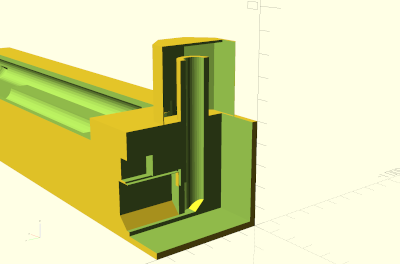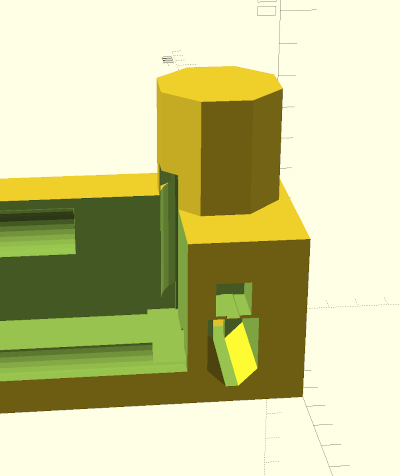The “Mr Redox” Home Energy Reactor (by alaric)
So, I work from home, which means I spend a lot of time in my workshop.
It's a long, thin, building. The door opens into the metalworking area; moving along the building, we get to the electronics bench, then to my desk. As I've previously mentioned, I want to redesign the place a bit, but I'll still be spending a lot of time in here. I have insulated the roof successfully, but the second front in my war against chilliness is my rocket mass heater.
A rocket mass heater is, when all's said and done, a machine for turning flammable things (plus air) into heat (and air with carbon dioxide and moisture added to it), plus a small amount of ash. "That's a fire", you might think, and you're right: it's a redox reaction, and certainly involves flames, but it's somewhat different from what you might think of when imagining heating a room with a fire.
You see, if you just make a pile of wood and set fire to it, like a camp fire, it's not very efficient. Heat is radiating out in all directions, meaning that the wood is only really hot enough to burn properly down inside the fire; the wood around the outside just smoulders. The smoke that rises up is hot, carrying heat away directly, and also the smoke itself - particles of carbon-rich matter - is pretty much made of unburnt fuel.
The next logical step is to have a closed-in combustion chamber lined with insulating bricks, like a conventional wood burning stove; this means that the entire interior can be at efficient burning temperature, leading to more of the wood burning properly and less unburnt stuff in the smoke. Also, an enclosed box means you can control the air flow into the heart of the fire; combined with the suction caused by hot flue gas rising up a tall, thin, chimney this means you can direct a roaring jet of fresh air into the burny bits, leading to rapid combustion.
But there's still a lot of hot air and unburnt smoke particles going up that chimney. Can we do better?
Yes we can. Oh, yes we can. Allow me to introduce... the "Mr Redox" Home Energy Reactor, here being appreciated on a cold day by Helium, the workshop cat:
The bottom part looks a lot like a normal wood-burning stove, and it is; the door opens, wood goes in, air comes in through the air vent at the bottom, the wood burns.
But this is where a rocket mass heater differs from a conventional firebox. Rather than having a chimney rising up from the firebox, we instead have a slot at the back of the box. A second air vent - fed by the upper air vent on the door - injects extra fresh air into the roaring flamey smokey stuff going out there.
Let's have a look at a cross-section of the front end:

You can see the firebox at the lower left, and the chamber above it is the manifold whereby secondary air comes in, along the top of the firebox, and down to the slot at the rear of the firebox.
The hot flames and smoke - now with extra secondary air added - goes into a tall vertical tube, made of refactory insulator (I mixed a load of horticultural perlite with high temperature castable refractory). The insulation means that the interior of the tube gets very hot, which in turns means that the smoke burns in the secondary air, releasing additional heat and fully breaking the fuel down into carbon dioxide and water vapour (plus anything that ends up as ash in the firebox).
This hot air is then released into the primary heat exchanger - the big black box on top in the picture, which is made of steel. This conducts the heat out, cooling the air as it drops down the sides of the secondary burn tube; as it cools it gets denser and falls faster, sucking air through the system and encouraging vigorous combustion in the firebox and secondary burn tube. The primary heat exchanger gets pretty hot, usually around three hundred degrees Celcius when it's running normally, and more like five hundred when I'm pushing it hard. This radiates heat into the room, and has a drastic warming effect.
The hot flue gasses drop down into a cavity to the left of the firebox (not visible in the cross section), and then flows into the secondary heat exchanger:

This is a large brick box, packed with sand:
As you can see, I've put some nice tiles on top of it, and a Thai cushion.
Inside the secondary heat exchanger, the flue pipe snakes back and forth - three times in total - before going up the chimney. This means that the hot gasses lose their heat to the sand and masonry, so the stuff going up the chimney is only at about thirty degrees Celcius; the chimney gets pleasantly warm to the touch, never hot. And thus, the heat lost to the outside world is reduced considerably compared to a conventional fire.
The heat energy stored in the sand and bricks can be significant, but it only leaks out slowly - the outside of the heat exchanger never feels warm to the touch, but when I come in the morning after having run it the day before, it's not cold; it serves to keep the temperature up over night and into the next morning.
Pages: 1 2



By Priya Samuel, Sun 28th Mar 2021 @ 7:54 pm
Fascinating!! Until now I thought the rocket mass heater was a fancy name for a fireplace. And also, I’m so glad that Helium isn’t combustible 😉
By Joel, Mon 26th Apr 2021 @ 9:17 am
Hej! I'd like to build a rocket mass heater like yours with a proper bottom part like a normal wood-burning stove.
Can you share your drawings, tips and experiences of building a RMH? J